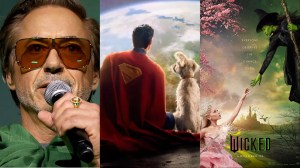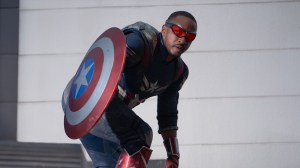When you’re making a film and need to convey a futuristic society, filmmakers don’t often take into account how future societies will react to seeing their time period reflected in a movie from the past. Instead, sometimes it’s easier to make assumptions and creative leaps about what future societies will be like, which sometimes end up being accurate and other times wildly miss the mark.
Videos by ComicBook.com
In some cases of predicting the future, sci-fi stories emphasize the technology we’ve created, what with flying cars, faster than light travel, or robotic reliance. In other cases, sci-fi stories project what type of society humans might devolve into, like politics, law enforcement, and war. Many films have predicted different types of natural disasters that can’t be avoided, and those could virtually happen in any year, so those films won’t be considered. Instead, we’ll take a look at ways the films of the past have predicted a future we’ve already moved on from.
What are your favorite cinematic visions of the future? Let us know in the comments!
MORE MOVIE NEWS: Doctor Strange Seemingly Confirmed For Thor: Ragnarok / Mean Girls Musical Slated for Fall 2017 Premiere / Ridley Scott Explains Why He Won’t Do Superhero Movies / Marvel’s Best Shirtless Moments All In One Video
2001: A Space Odyssey (1968)
Stanley Kubrick teamed up with Arthur C. Clarke to chronicle a future society discovering a strange monolith being discovered on the moon. Two of the biggest inferences into what society would be like in 2001 are the advancements in outer space transportation and the dependency on technology, specifically the HAL 9000, an onboard artificial intelligence. Even though we haven’t quite caught up to the technology in the film, Virgin Galactic is currently developing technology for commercial space travel and with software like Siri and Alexa, man’s dependence on technology to get through the day has never been stronger than it is today, with no end in sight.
[H/T YouTube/Stanley Kubrick]
Death Race 2000 (1975)
Set in the year 2000 (duh), the annual Transcontinental Death Race pits the world’s best drivers against one another to drive across the country, causing as much violence, gore, and death as they can, all for the enjoyment of the rest of the world. Luckily, our current society isn’t quite as frank in our desires to see blood and guts to satisfy our primal curiosities, but the growing number of reality TV shows that showcase some of the worst traits in humans (and admittedly, sometimes good qualities) makes the concept of a reality show featuring real murder seem no so far away. It might only be a few more years before we see Road Rules: Death Race on MTV.
[H/T YouTube/Roger Corman [Official YouTube Page]]
Escape from New York (1981)
John Carpenter’s Kurt Russell-starring dystopian masterpiece features Snake Plissken having to infiltrate the island of Manhattan, which, in 1997, had been cordoned off as a maximum security population. The low budget filmmaking didn’t showcase technology that was too far-fetched, but rather explored what could potentially happen to society if crime rates continued to increase. In the film’s 1996 sequel, Escape from L.A., Plissken must again infiltrate a maximum security community, but this time it is in a section of California that has split from the continental United States following a massive earthquake. This film was set in 2013, and again features a dystopian society, but neither of the societies in these films have we quite devolved into (yet).
[H/T YouTube/TrailerCraze]
1984 (1984)
Based on George Orwell’s 1949 novel, 1984 envisioned a future with an omnipresent, tyrannical leader, whose public image was “Big Brother,” who might not even be a real person. The story was prolific, as our advancements in technology have put virtually every corner of civilization under watch, either by video cameras, GPS, and computer hacking software. Although we haven’t quite gotten to people being arrested for “thought crimes,” anything that could weaken the political regime, the manipulation of power in different countries around the world makes this fiction seem ever closer to becoming a reality.
[H/T YouTube/MisterMaxHeadroom]
Back to the Future Part II (1989)
Following the further adventures of Marty McFly (Michael J. Fox), the time-traveler heads to 2015 to see all the ways that society has changed. For the most part, society itself is pretty similar, but this comedy from the ’80s ran wild with what clothing, film, and food would look like. When reality caught up to the fictional timeline, Nike went so far as to recreate self-tying shoes that were featured in the film, and in 2016, the Chicago Cubs won the World Series, with this film predicting they would have won in 2015. Luckily, one prediction of Back to the Future Part II that never came true was Jaws 19, as the plot of Jaws: The Revenge and its shark that is deliberately killing members of a specific family in retaliation was as ridiculous as the series was willing to get.
[H/T YouTube/Movieclips]
Terminator 2: Judgment Day (1991)
Terminator 2: Judgment Day focuses on the T-800 (Arnold Schwarzenegger) being sent from 2029 by John Connor to protect a younger John Connor from another robot that was sent to kill him. Yes, it’s a little confusing on paper, but the significant event in the film is the titular “Judgment Day,” which is when Skynet, a computerized artificial intelligence, gained control of the world’s nuclear weapons, using it to wipe out most of humanity. In 2017, robots still mostly look like robots and have a hard time passing for humans, but advancements in self-driving cars that we willingly let take us on long voyages, it’s not too hard to imagine a malfunction that could turn a well-meaning interface into a death trap.
[H/T YouTube/harveyknowsbest]
Timecop (1994)
In Timecop, Jean-Claude Van Damme stars as a federal agent who, when time travel has been discovered in 2004, uses the technology to prevent criminals who exploit the technology for personal gain. Sadly, even in 2017, time travel hasn’t been discovered (that we know of), but we did have a TV show in which another ’90s action star (Steven Seagal) became an actual member of law enforcement, so maybe we aren’t too far away from seeing Van Damme become an actual cop, minus the time travel.
[H/T YouTube/Jean-Claude Vandammelibrary]
Strange Days (1995)
Set in the year 1999, Strange Days envisioned a future where a person could obtain SQUID discs, which record a users experiences, sensations, and memories, which Ralph Fiennes’ character attempts to use to discover the identity of a murderer. Society is still pretty far off from recreating the sensations of another human, but given the prominence of social media, it’s never been easier for one to publicly document the ins and outs of their daily lives, no matter how mundane and uninteresting those lives are. Platforms like Snapchat only make these pictures and videos live for 24 hours, but many other platforms have more permanence to them, so it’s just a matter of technology to document everything about your life catching up to the desires of society to consume it.
[H/T YouTube/WorleyClarence]
Barb Wire (1996)
Set in 2017 in the middle of the Second American Civil War, Barb Wire features Pamela Anderson as the titular character who runs a nightclub while moonlighting as a mercenary and bounty hunter in Steel Harbor, the “last free city.” Rather than describe all the ways in which society was envisioned to be in 2017, I recommend you watch the film, as it’s no longer a piece of fiction but a documentary. Let’s just say the next 12 months are going to be rough.





